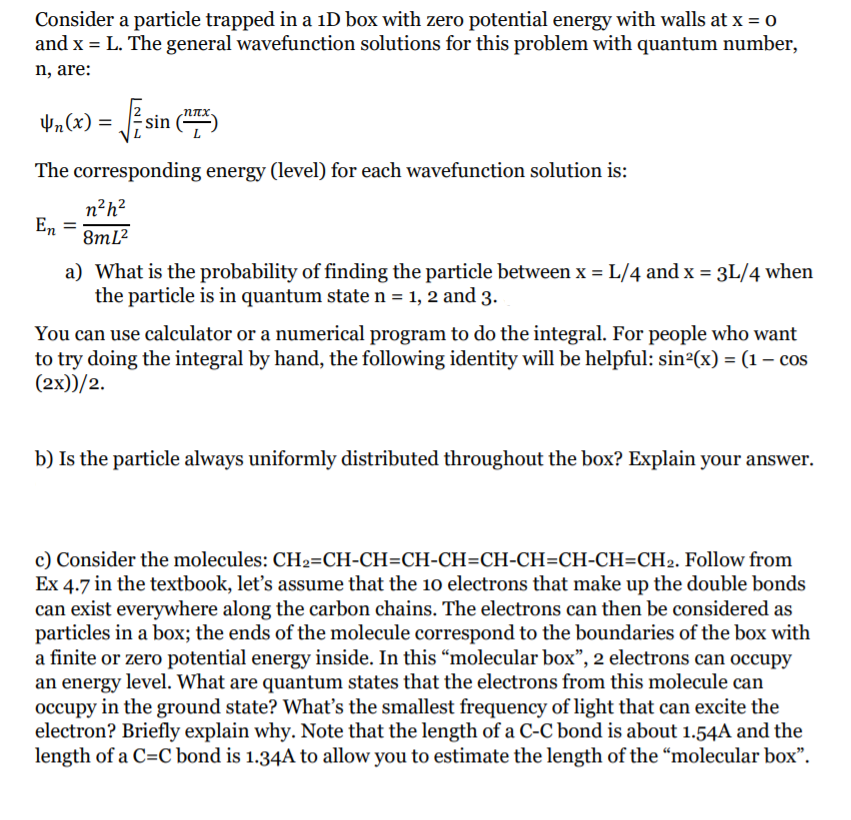Consider a particle trapped in a iD box with zero potential energy with walls at x = 0 and x = L. The general wavefunction solutions for this problem with quantum number, n, are: Esin Wn(x) = The corresponding energy (level) for each wavefunction solution is: n?h? En 8ml? a) What is the probability of finding the particle between x = L/4 and x = 3L/4 when the particle is in quantum state n = 1, 2 and 3. %3D
Consider a particle trapped in a iD box with zero potential energy with walls at x = 0 and x = L. The general wavefunction solutions for this problem with quantum number, n, are: Esin Wn(x) = The corresponding energy (level) for each wavefunction solution is: n?h? En 8ml? a) What is the probability of finding the particle between x = L/4 and x = 3L/4 when the particle is in quantum state n = 1, 2 and 3. %3D
Principles of Modern Chemistry
8th Edition
ISBN:9781305079113
Author:David W. Oxtoby, H. Pat Gillis, Laurie J. Butler
Publisher:David W. Oxtoby, H. Pat Gillis, Laurie J. Butler
Chapter5: Quantum Mechanics And Atomic Structure
Section: Chapter Questions
Problem 6P: Using Table 5.2, write down the mathematical expression for the 2px wave function for an...
Related questions
Concept explainers
Atomic Structure
The basic structure of an atom is defined as the component-level of atomic structure of an atom. Precisely speaking an atom consists of three major subatomic particles which are protons, neutrons, and electrons. Many theories have been stated for explaining the structure of an atom.
Shape of the D Orbital
Shapes of orbitals are an approximate representation of boundaries in space for finding electrons occupied in that respective orbital. D orbitals are known to have a clover leaf shape or dumbbell inside where electrons can be found.
Question

Transcribed Image Text:Consider a particle trapped in a iD box with zero potential energy with walls at x = 0
and x = L. The general wavefunction solutions for this problem with quantum number,
n, are:
Vn(x) =
The corresponding energy (level) for each wavefunction solution is:
n?h?
En
8ml?
a) What is the probability of finding the particle between x = L/4 and x = 3L/4 when
the particle is in quantum staten = 1, 2 and 3.
%3!
You can use calculator or a numerical program to do the integral. For people who want
to try doing the integral by hand, the following identity will be helpful: sin²(x) = (1 – cos
(2х))/2.
b) Is the particle always uniformly distributed throughout the box? Explain your answer.
c) Consider the molecules: CH2=CH-CH=CH-CH=CH-CH=CH-CH=CH2. Follow from
Ex 4.7 in the textbook, let's assume that the 1o electrons that make up the double bonds
can exist everywhere along the carbon chains. The electrons can then be considered as
particles in a box; the ends of the molecule correspond to the boundaries of the box with
a finite or zero potential energy inside. In this “molecular box", 2 electrons can occupy
an energy level. What are quantum states that the electrons from this molecule can
occupy in the ground state? What's the smallest frequency of light that can excite the
electron? Briefly explain why. Note that the length of a C-C bond is about 1.54A and the
length of a C=C bond is 1.34A to allow you to estimate the length of the "molecular box".
Expert Solution
This question has been solved!
Explore an expertly crafted, step-by-step solution for a thorough understanding of key concepts.
This is a popular solution!
Trending now
This is a popular solution!
Step by step
Solved in 3 steps with 2 images

Knowledge Booster
Learn more about
Need a deep-dive on the concept behind this application? Look no further. Learn more about this topic, chemistry and related others by exploring similar questions and additional content below.Recommended textbooks for you

Principles of Modern Chemistry
Chemistry
ISBN:
9781305079113
Author:
David W. Oxtoby, H. Pat Gillis, Laurie J. Butler
Publisher:
Cengage Learning

Physical Chemistry
Chemistry
ISBN:
9781133958437
Author:
Ball, David W. (david Warren), BAER, Tomas
Publisher:
Wadsworth Cengage Learning,

Chemistry: The Molecular Science
Chemistry
ISBN:
9781285199047
Author:
John W. Moore, Conrad L. Stanitski
Publisher:
Cengage Learning

Principles of Modern Chemistry
Chemistry
ISBN:
9781305079113
Author:
David W. Oxtoby, H. Pat Gillis, Laurie J. Butler
Publisher:
Cengage Learning

Physical Chemistry
Chemistry
ISBN:
9781133958437
Author:
Ball, David W. (david Warren), BAER, Tomas
Publisher:
Wadsworth Cengage Learning,

Chemistry: The Molecular Science
Chemistry
ISBN:
9781285199047
Author:
John W. Moore, Conrad L. Stanitski
Publisher:
Cengage Learning

Chemistry: Principles and Practice
Chemistry
ISBN:
9780534420123
Author:
Daniel L. Reger, Scott R. Goode, David W. Ball, Edward Mercer
Publisher:
Cengage Learning

Organic Chemistry: A Guided Inquiry
Chemistry
ISBN:
9780618974122
Author:
Andrei Straumanis
Publisher:
Cengage Learning

Chemistry for Engineering Students
Chemistry
ISBN:
9781337398909
Author:
Lawrence S. Brown, Tom Holme
Publisher:
Cengage Learning